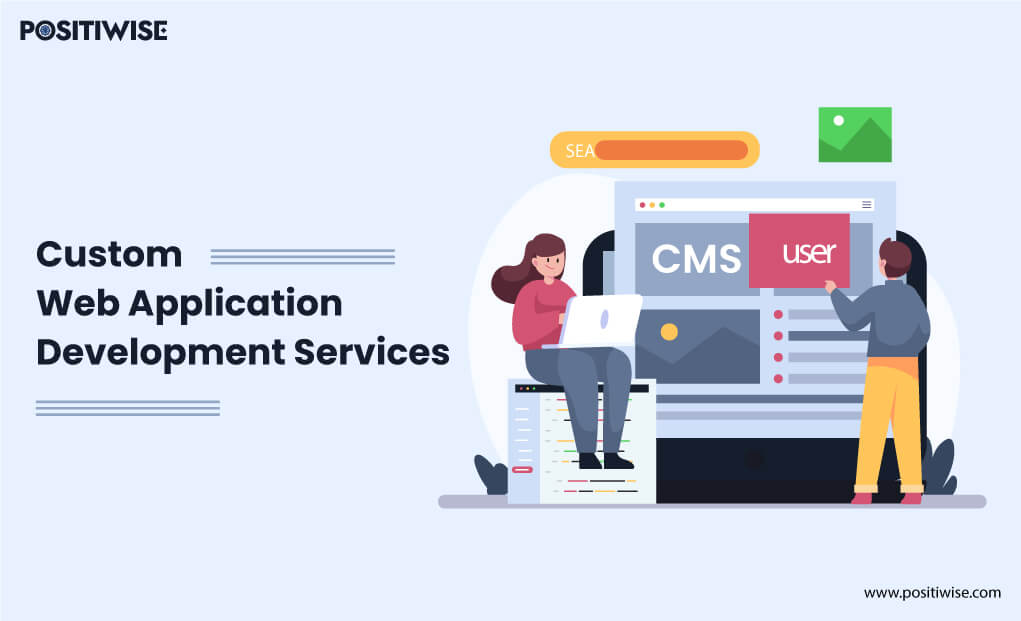Quick Overview:
Now, you can avail yourself of all the significant details about custom web application development services. In this blog, you can discover the types of custom web applications and technologies available to curate the server and client side of the software. In addition, you will also get exposure to the procedure followed by professional developers for providing custom web app development services.
Introduction
Custom web applications have always been a preferred choice of organizations. It provides them the leverage to scale, align with new trends, and acquire more customers. Even in the age of mobile apps, custom web application development still retains its position in the top preferences. And there are many reasons behind it, such as extensive types of web apps fulfilling every requirement, affordable development, top-notch tech stacks, and more.
We have curated everything in this blog that you need to understand about custom web application development services.
What is Custom Web App Development?
When you develop a web application precisely according to your requirements, it’s known as a custom web application. Such apps work according to your organizational needs and help to achieve technical and business goals.
For instance, if you use Salesforce browser-based software, it’s a web app. But it’s not a custom one, as Salesforce has the code, IP, and other rights. On the other hand, suppose you hire developers to build data management software for your company using .NET, Python, Java, or any other technology. Then, that software piece will be a custom web application. To own such an application, you need to avail yourself of custom web application development services.
What Do Custom Web Application Development Services Include?
Custom web application development services are of different types, and you should understand them. It will help you select the most appropriate services for your business, supporting you in accelerating productivity. You can find all the top eight custom web applications trending in 2024 here.
- Static Web Application Development
- Dynamic Web Application Development
- SPA Development (Single Page Application)
- Progressive Web Application Development
- Portal Web Application Development
- Animated Web Application Development
- eCommerce Web Application Development
- CMS Web App Development (Content Management System)
Static Web Application Development
The software doesn’t communicate with the server in static web application development. It’s just a website built using HTML, CSS, and JavaScript, which displays the same content each time. Mostly, organizations utilize it for displaying information with minimal images and other media components.
In addition, such web apps load faster than others, as only client-side technologies are in use. These are also affordable to develop and easy to maintain.
Dynamic Web Application Development
BY availing of a dynamic web application development service, you can build a responsive solution. Such applications communicate with servers to resolve user queries and process their requests. The most common example of a dynamic web app is Gmail. When you access gmail.com on a browser, it takes your account credentials as input and transmits it to the server for authentication. In response, it acknowledges the browser for allowing you to access the mail services. Both client and server-side technologies, such as .NET, PHP, and JavaScript, are used to build dynamic web applications.
Save Time and Resources with Custom-Built Web Apps
Tired of piecing together disjointed systems? Our expert web developers build fully customized web apps to streamline your workflows seamlessly. Save time, cut costs, and drive efficiency with tailored solutions made for your unique needs.
SPA Development (Single Page Application)
You can consider single-page applications as a type of dynamic web app. But, SPAs execute their logic in the browser only. Due to this, the performance and speed of SPAs are readily faster, helping to improve user experience and satisfaction rate. You can effortlessly develop an SPA within business constraints and take advantage of its fewer resource and processing power requirements.
Progressive Web Application Development
PWA applications are prevalent nowadays. These types of applications are considered for achieving cross-platform compatibility goals. You can leverage your users to access a PWA app on a mobile browser and utilize all native functionalities.
In addition, progressive web apps are SEO-optimized, responsive, cost-effective to build, and outperform as compared to other web app types. Moreover, the frameworks used to develop them benefits by offering built-in security mechanism to retain data integrity.
Furthermore, some prominent examples of PWA include Twitter Lite, Google Maps Go, Flipboard, and more.
Portal Web Application Development
Organizations and enterprises use portal web applications for internal use. It helps them to verify the user identity before providing access to internal files, networks, and resources. You can also consider it an intranet portal employees use to log into their professional accounts.
The primary goal of such web applications is to allow users defined by the organization and to ensure utmost security. You can see it everywhere, like in colleges, government offices, banks, private companies, and more.
Animated Web Application Development
When media components, such as GIFs and videos, get used for making interfaces alluring, it’s called an animated web application. The main reason for using animations is to make the application appealing and increase retention.
However, you must follow all the performance and speed optimization practices for such an app. Otherwise, it can take more than the required time to load, increasing the bounce rate. You can efficiently implement all the essential practices by hiring an experienced company for custom web application development services.
eCommerce Web Application Development
eCommerce businesses are rising in 2024, and most of them are using web applications for digital presence. This type of application provides online payment, content management, data security, and more such functionalities.
Flipkart, Amazon, Derma Co, Alibaba, Mama Earth, Boat, and many more companies operate their eCommerce web application. They mostly prefer technologies like ASP.NET Core, Java, PHP, CSS, AngularJS, and ReactJS to develop their apps.
CMS Web App Development (Content Management System)
You can consider a web app as a blogging website or an online personal portfolio. The primary purpose of the CMS system is to display the content in a structured manner. The content can include text, images, video links, and documents.
CMS web app development technologies don’t require much programming knowledge, as they provide pre-build templates. WordPress, Strapi, Drupal, and Joomla are the top tech stacks you can consider for developing your CMS software.
Server-Side Technologies For Custom Web Application Development
Following are the top server-side technologies used for custom web app development.
.NET
.NET development is a development model from Microsoft, consisting of numerous frameworks and libraries to facilitate the creation of web applications. It leverages the use of .NET Framework, .NET Core, ASP.NET, ASP.NET Core, .NET Standard, C#, F#, and VB.NET. The top-notch speed, cross-platform compatibility, and high-end security mechanisms make .NET development a reliable choice.
Python
Python programming language is in high demand for curating web apps. It offers the benefits of extensive support libraries, open-source architecture, and easy-to-implement syntax for any business logic. The apps running Python in their backend seamlessly automate tasks and optimize memory management.
PHP
PHP is a server-side language providing the scripting advantages for creating new-age dynamic web apps. It adds enormous flexibility and speed to your software, helping to improve collaboration with the server to provide faster and more accurate responses.
NodeJS
This single-threaded, asynchronous, and open-source server-side technology ensures to retain the performance regardless of the user traffic. Using it can enhance the response time and even help you save money on developing a web application.
Ruby on Rails
The MVC architecture of Ruby on Rails aids in individualizing the interface and business logic. It helps to readily manage large applications, deploy them faster, and seamlessly upgrade them. You can also prefer it for using automated deployment and convention instead of configuration.
Java
Everyone knows about Java, as it’s the most popular object-oriented language. It’s platform-independent, simple, secure, and highly robust to serve as the backend of a web application. With its multithreaded functionality, it can exponentially improve the speed and output.
Client-Side Technologies For Custom Web Applications
Whenever you consult with a company for custom web application development and services, you will assuredly get an option to select from below client-side technologies.
AngularJS
AngularJS is a typescript-based development platform that efficiently builds single-page applications. It aids in implementing HTML data binding capabilities and reusing the components for faster development of charismatic software.
ReactJS
The assurance of stable code, SEO-friendly components, and a composable architecture makes ReactJS a preferred choice. It helps to simplify user interfaces and streamline the experience for all customers.
VueJS
It’s a lightweight and incrementally adoptable client-side technology, providing a lightning-loading speed. The virtual DOM is its top benefit, boosting performance, reducing complexity, and streamlining web application updates.
HTML & CSS
HTML is used for developing static web applications, as it can build the structure and display content to the end-users. In addition, CSS is used to extend the functioning of an HTML web app. It offers faster speed and supports improving the interface with colors, fonts, and more.
JavaScript
JavaScript supports reducing the server load and building a rich interface to ease web app usage. JavaScript’s interoperability, event handling, and scripting advantage help optimize web app metrics.
Steps To Build Custom Web App Development
When you avail of custom web application development and services, the following steps are performed to reach the initial to final stage. The steps are as follows:
- Step 1: Consult and Define
- Step 2: Design and Prototype
- Step 3: Develop and Integrate
- Step 4: Test and Deploy
- Step 5: Maintain, Support, and Upgrade
Step 1: Consult and Define
In the initial phase, the web app development company lists down all the requirements and defines project goals, objectives, timelines, and costs. The server-side and client-side technologies are also selected, and developers proficient in those technologies are onboarded.
After signing all the documents, the project gets moved to the next step.
Step 2: Design and Prototype
The web app designers in the development team consider all the defined objectives. They design the web application interface and architecture. Simultaneously, the developers build the business logic for server-side purposes.
In addition, if required, a prototype gets built with minimal functionality to showcase features and look. Whether the prototype gets finalized or changes are provided depends on the client. But, once the design and prototype are selected, development starts.
Step 3: Develop and Integrate
At this step, developers start their work. They take the design and prototype as their reference to build the custom web application. All the client and server-side code are written, debugged, and unit tested at this stage. Moreover, third-party APIs and services are integrated at this stage too.
After checking the code, developers move the web application to testers. However, the developer’s work didn’t complete here. If testers find a vulnerability or lack of functionality, they will notify the developers and then have to complete that task until all objectives are met.
Step 4: Test and Deploy
Testers use different testing techniques, such as black box, white box, and grey box, to ensure that the web app functions per requirements. In addition, they also check platform compatibility, third-party integrations, overall functioning, performance, speed, and data security.
After successful testing and patching, system admins take control and deploy the web application per the defined model. As a result, end-users get their hands on the app to use authorized services.
Step 5: Maintain, Support, and Upgrade
This is a continuous step, as web application needs to be maintained and upgraded until they are active. During maintenance, the primary purposes are to retain performance, upgrade security controls, improve scalability, reduce bounce rate, and handle all the requests within minimal time. With the help of an expert web app development company, undergoing such a procedure becomes a worry-free task.
Concluding Up
Custom web application development services are trending, as every firm requires software built specifically for them. Custom web apps can be built of different types: static, dynamic, single page, portal, eCommerce, CMS, animated, and progressive web applications. It all depends on the business’s needs to choose between all available types.
In addition, you can find numerous server and client-side technologies for custom web app development. You should prefer the listed tech stack, consisting of .NET, Java, Python, WordPress, AngularJS, HTML, ReactJS, and others. And if you want to streamline every task, consult a development company.
Expert in Marketing Strategy and Brand Recognition
Jemin Desai is Chief Marketing Officer at Positiwise Software Pvt Ltd, he is responsible for creating and accelerating the company’s marketing strategy and brand recognition across the globe. He has more than 20 years of experience in senior marketing roles at the Inc. 5000 Fastest-Growing Private Companies.






